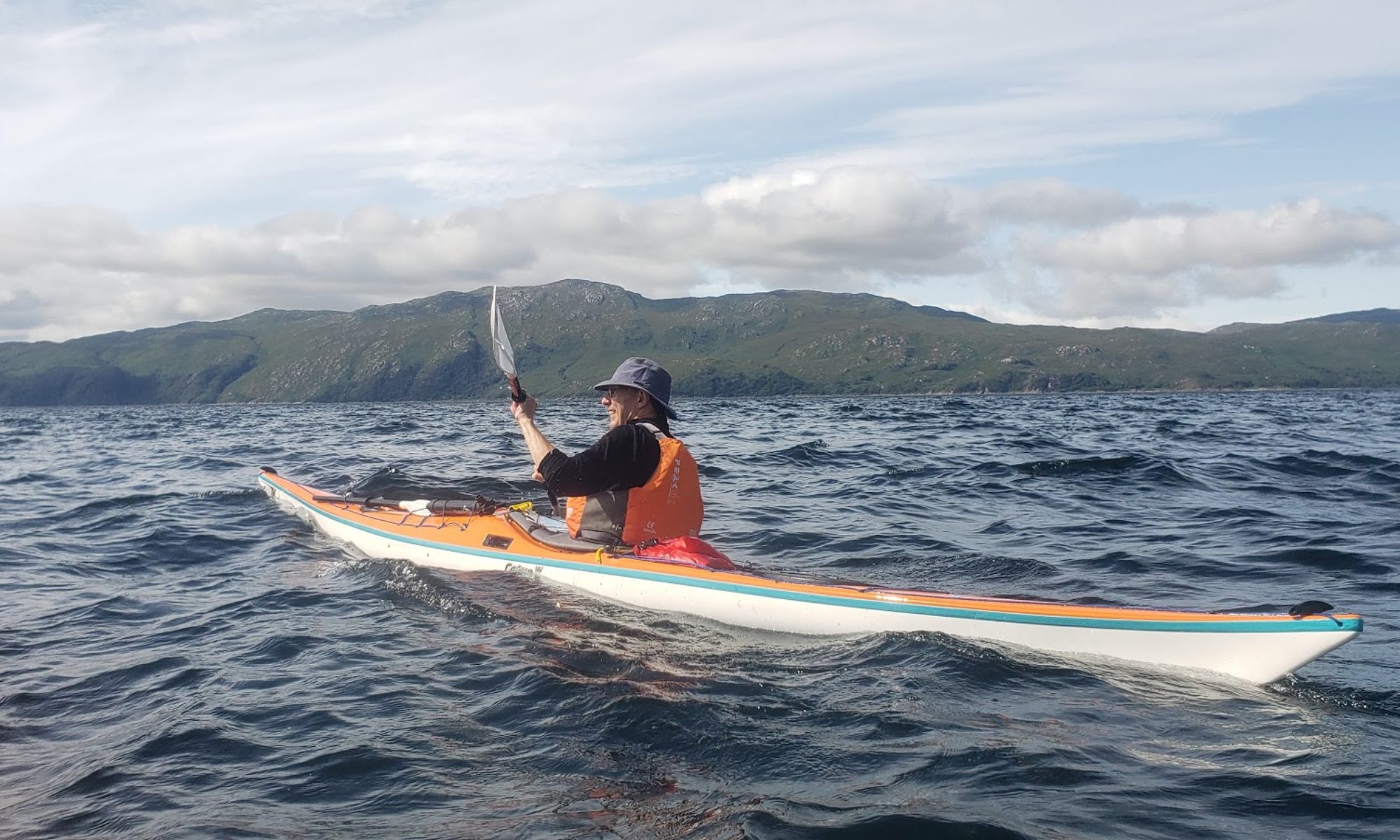
Double Click on photos and maps for full screen.
Paddlers: Hugh, Ken, Geoff, Innes and Douglas
Weather: Lovely but windy on Saturday getting less windy but more cloud as weekend progressed, with heavy showers day and night.
Route:
Report: Slightly late we left Helensburgh at 7.30 aiming for the 10.20 from Lochaline to Mull and made it easily. A rather slow drive across Mull got us to Ulva Ferry around 11.30 and on the water at 12noon.

There was a brisk northerly F4 blowing but a decision was nevertheless made to go on the north side of Ulva, with the option of cutting through the channel between Ulva and Gometra if there was doubt about the crossing to the Treshnish. So it proved and we stopped at the wee bridge joining the two islands for a break and because the channel was still dry.

By the end of lunch the channel had still not filled sufficiently so we waded through. Almost immediately after resuming the paddle a Sea Eagle appeared soaring above us.

The original plan had been to creep up the end of Gometra before crossing but it rapidly became clear that we would need to wait for the wind to go down. We stopped at a potential camp site with a view north with a poor landing on wet, seaweed covered extremely slippy rocks and waited in the sun

By 6pm it became clear that progress was not going to be possible and this was to be the camp site. Here is where the Strops come in. Hugh had designed a pair of lifting strops that proved a godsend in getting the loaded boats up (and down) over the terrible beach. These proved invaluable.

If there are four of you and you have strops, the camp site is strongly recommended with large relatively flat area, good pegging and a supply of driftwood. The latter provided the fuel for a good camp fire with turn in sometime after 11pm with an agreed rise at 7.oo for a departure at 8.30. Otters also frequent the area.

Overnight there was heavy rain which damped both tents and wind. However it stopped at 7 and stayed away most of the morning. We headed directly for Carn na Burgh into the increasing wind. Although both islands have fortification and history both have terrible landings with Beag almost impossible. The views however were fantastic.

Some History: The two islands have a long history as part of the boundary between the Norse and Gaelic cultures. Easily fortified they were used in a number of clan battles including the battle between the Maclean’s and Argyll in 1680 that ended with the supremacy of Argyll. Its last use was during the 1715 rebellion when it was occupied for the Jacobite cause by the MacLeans whose chief had been imprisoned by Argyll.
The paddle was then south to Lunga past Fladda and a host of islets and skerries. The wind had been picking up all morning and winds caused a few flutters as the kayaks surged forward. The landing on Lunga was again on rocks although they were somewhat smaller. There we joined yachtsmen and tourists off the multiple boats that operate from Fionphort, Bunessan and Ulva Ferry. The attraction was the magical puffin colony where hundreds of Puffins in their Sunday best parade for the camera.



The numerous tourist boats were eventually joined by a Cruise Liner!

From Lunga we headed directly to one of the most incredible places in Scotland. Staffa is formed of nearly perfect hexagonal vertical columns of basalt sandwiched between sandstone and at its most magnificent has three large sea caves.

Mackinnon’s Cave is the largest with a wonderful vaulted entrance. The Boat Cave is the deepest and houses a pair of nesting guillemots. In their distress at being disturbed they accurately dive bombed Ken with rather smelly faeces. Ken alone was not amused at this sign of good luck.
One amazing phenomenon at this point is the tilting ocean. The columns are vertical on the sandstone but the sandstone layer is slightly tilted. It seems impossible for the brain to cope.

The third cave, Fingal’s, is the masterpiece with vaulting throughout its length.
The public are able to access the cave by a path at the base of the basalt. The tourists during our visit not only had the magnificence of the cave but 5 beautiful sea kayaks to admire.

We had a quick break at the only “beach” at Clamshell Bay, another rough rocky landing. After much discussion we headed back to Gometra in degenerating weather, reaching there about 6pm. It had been a fantastic sea kayaking day with two amazing natural phenomena and around 20 miles of excellent kayaking in fantastic surroundings.
Monday promised a relatively short paddle along the south side of Ulva to get us home for early evening. The cliff scenery was excellent the whole way and the wind , now from the South, had little impact. We stopped at a private bothy at Cragaig used by at least one kayak club. Perhaps a winter trip?


We arrived back at Ulva Ferry at about 1pm and decided to take lunch in the Boat House cafe on the island. This was excellent (if slightly expensive) and the Heritage Centre (Free) was well worth the 2 minute walk from the cafe. In stark terms it described the clearance of Ulva/Gometra from a populationof 850 at the start of the nineteenth century to 15 in 1981.
Finally a quick paddle across the Sound and home.



